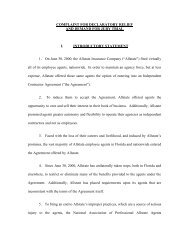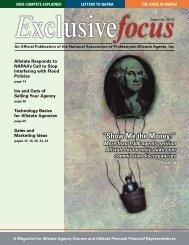Exclusivefocus Spring 2013 - National Association of Professional ...
Exclusivefocus Spring 2013 - National Association of Professional ...
Exclusivefocus Spring 2013 - National Association of Professional ...
You also want an ePaper? Increase the reach of your titles
YUMPU automatically turns print PDFs into web optimized ePapers that Google loves.
feature<br />
Agent Pension Plan Information for<br />
Former Allstate Employee Agents<br />
By Nancy Fish<br />
For the most part, Allstate stopped<br />
hiring employee agents in 1990.<br />
Then in the year 2000, the company<br />
terminated all its remaining employee<br />
agent contracts, except for those located<br />
in certain jurisdictions, such as the state<br />
<strong>of</strong> New Jersey.<br />
At the time, the company had 6,171<br />
employee agents who were affected by<br />
the “Preparing for the Future” initiative,<br />
wherein agents were allowed to continue<br />
their careers only if they agreed to become<br />
independent contractors and suffer<br />
the loss <strong>of</strong> their employee benefits.<br />
Most <strong>of</strong> those affected were over the age<br />
<strong>of</strong> forty.<br />
Of the 6,171 affected agents, 3,772<br />
converted to the EA agreement and continued<br />
their agency relationship; 2,399<br />
selected another option, and parted ways<br />
with the company. Virtually all 6,171<br />
employee agents were vested in the Allstate<br />
Agent Pension fund at the time<br />
their employment contract was severed,<br />
and many <strong>of</strong> those are now approaching<br />
retirement age.<br />
Vesting in the pension plan required a<br />
minimum <strong>of</strong> five years as an employee <strong>of</strong><br />
Allstate. Employment at Sears prior to<br />
1995 could also be counted towards vesting<br />
eligibility for Sears employees who<br />
left and became Allstate agents. Vested<br />
former employee agents who were not<br />
yet 65 when employment ended became<br />
“terminated deferred vested Participants.”<br />
Who is eligible to withdraw<br />
benefits under the plan<br />
Normal retirement age is 65. Agents<br />
hired before 1989 are eligible to receive<br />
early retirement benefits payable at age<br />
63. In addition, agents with 20-plus<br />
years <strong>of</strong> continuous employment can receive<br />
early retirement benefits at age 55.<br />
Early retirement benefits – paid prior<br />
to age 65 – are calculated at a reduced<br />
amount based on your actual age.<br />
Current Allstate Exclusive Agent independent<br />
contractors can take their<br />
retirement benefits as soon as they are<br />
eligible based on age and years <strong>of</strong> employment.<br />
In other words, you may collect<br />
your benefit while still under contract<br />
as an EA independent contractor<br />
agent.<br />
The deferred vested benefit is payable<br />
as an annuity. While several annuity payout<br />
options are available, it is important<br />
to note that monthly payout amounts<br />
are “frozen” and will not change as the<br />
participant ages. Currently, a lump-sum<br />
payout option is still available, but the<br />
plan is under no obligation to continue<br />
it. The lump sum is calculated by applying<br />
a conversion factor – which includes<br />
interest rate and mortality assumptions<br />
– to the straight life annuity benefit.<br />
Consequently, the benefit amount under<br />
the lump sum option may increase<br />
or decrease depending on the prevailing<br />
assumptions in effect at the time a lump<br />
sum is requested.<br />
The Pension Protection Act (PPA) <strong>of</strong><br />
2006 changed the interest rate used to<br />
calculate lump-sum payouts <strong>of</strong> the Agents<br />
Pension Plan from the 30-year Treasury<br />
Bond Rate to a corporate bond segmented<br />
yield curve. As a result, there is no longer<br />
a single interest rate used for lump-sum<br />
payments. As a general rule, if the average<br />
interest rates decrease, the lump sum<br />
equivalent increases, and vice versa.<br />
If you receive your pension benefit in a<br />
lump sum, you can “roll” it into an IRA<br />
32 — <strong>Exclusivefocus</strong> <strong>Spring</strong> <strong>2013</strong>
















